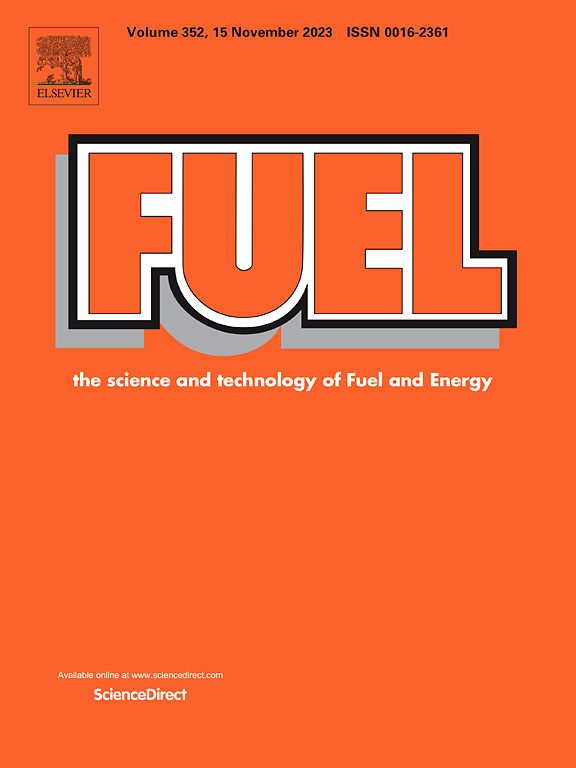NH3/PODE3共混物层流燃烧速度和点火延迟时间的实验与动力学建模研究
IF 7.5
1区 工程技术
Q2 ENERGY & FUELS
引用次数: 0
摘要
氨-聚氧亚甲基二甲醚(PODE3)双燃料模式在提高氨燃烧性能、降低碳相关排放和污染物排放、促进氨燃料发动机的广泛应用方面具有很大的潜力。在这项研究中,使用快速压缩机(RCM)在宽温度(Teff)范围内和高压(Peff)下测量了NH3/PODE3共混物的点火延迟时间(IDTs)。此外,采用定容燃烧容器,在较宽的初始压力、温度和氨摩尔比(AMRs)下,测定了NH3/PODE3共混物的层流燃烧速度(LBVs)。结果表明,PODE3的掺入显著缩短了NH3的idt,增加了NH3的lbv。基于这些数据,建立了NH3/PODE3共混物的详细化学反应机理,包括319种反应和2015种反应。在广泛的实验条件下,对idt、LBVs和主要物种摩尔分数剖面数据进行了细致的验证,不仅包括纯NH3和纯PODE3,还包括不同氨馏分的NH3/PODE3共混物。结果表明,该机制在应用于NH3-PODE3双燃料发动机CFD模拟时具有较高的预测精度,从而验证了该机制的有效性和适用性。并进行通路分析和敏感性分析。结果表明:R9: PODE3 + NH2=PODE3B + NH3和R10: PODE3 + NH2=PODE3A + NH3仅在AMR = 92.5%和1.5 MPa条件下对IDTs敏感。链支反应r# 1: O2 + H = O + OH对LBV的敏感性系数最高。NNH自由基在NH3/PODE3共混物的idt和LBVs中都起着至关重要的作用,而CH3自由基在LBVs的富态中更为突出。结果进一步表明,增加AMR可以提高NH3/PODE3共混物的燃烧稳定性。本文章由计算机程序翻译,如有差异,请以英文原文为准。
Experimental and kinetic modeling study on laminar burning velocities and ignition delay times of NH3/PODE3 blends
Ammonia–polyoxymethylene dimethyl ether 3 (PODE3) dual fuel mode shows great potential in enhancing ammonia combustion performance, reducing carbon-related and pollutant emissions, and promoting the widespread application of ammonia-fueled engines. In this study, the ignition delay times (IDTs) of NH3/PODE3 blends were measured using a rapid compression machine (RCM) within a wide temperature (Teff) range at elevated pressures (Peff). Moreover, the laminar burning velocities (LBVs) of NH3/PODE3 blends were determined employing a constant-volume combustion vessel at wide initial pressures, temperatures, and ammonia molar ratios (AMRs). The outcomes demonstrate that the incorporation of PODE3 conspicuously shortens the IDTs and augments the LBVs of NH3. Based on these data, a detailed chemical reaction mechanism for NH3/PODE3 blends has been developed, encompassing 319 species and 2015 reactions. This proposed mechanism was meticulously validated against IDTs, LBVs, and major species mole fraction profile data over an extensive spectrum of experimental conditions, covering not only pure NH3 and pure PODE3 but also NH3/PODE3 blends with diverse ammonia fractions. The results evince a high degree of prediction accuracy when applying this mechanism, thereby corroborating the efficacy and appropriateness of the mechanism for CFD simulations in NH3–PODE3 dual fuel engines. Pathway analysis and sensitivity analysis were also conducted. The results demonstrate that the H-abstraction reactions of PODE3 by NH2 radical, R9: PODE3 + NH2=PODE3B + NH3 and R10: PODE3 + NH2=PODE3A + NH3, are sensitive only under the condition of AMR = 92.5 % and 1.5 MPa with respect to IDTs. The chain branching reactions, R#1: O2 + H = O + OH, exhibits the highest sensitivity coefficients for LBV. The NNH radical plays a crucial role in both IDTs and LBVs of NH3/PODE3 blends, whereas the CH3 radical is more prominent at rich regime for LBVs. The results further indicate that increasing AMR can enhance the flame stability of NH3/PODE3 blends.
求助全文
通过发布文献求助,成功后即可免费获取论文全文。
去求助
来源期刊

Fuel
工程技术-工程:化工
CiteScore
12.80
自引率
20.30%
发文量
3506
审稿时长
64 days
期刊介绍:
The exploration of energy sources remains a critical matter of study. For the past nine decades, fuel has consistently held the forefront in primary research efforts within the field of energy science. This area of investigation encompasses a wide range of subjects, with a particular emphasis on emerging concerns like environmental factors and pollution.
 求助内容:
求助内容: 应助结果提醒方式:
应助结果提醒方式:


